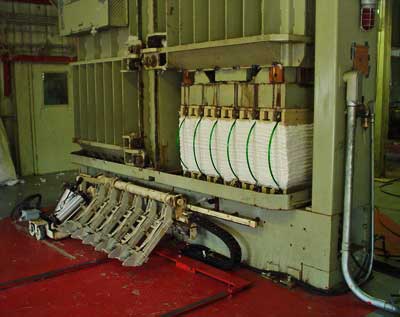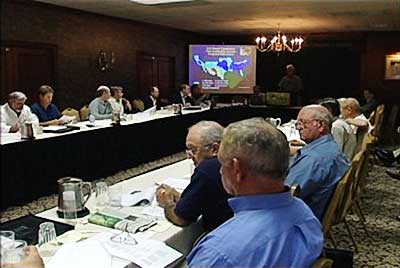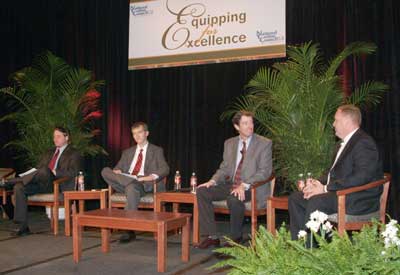Cotton Flow
USDA gave serious consideration to the National Cotton Council’s consensus positions when the agency issued its final rule governing storage, handling and ginning requirements for cotton pledged as collateral for a marketing assistance loan. Among other areas, the rule amended Commodity Credit Corporation procedures concerning the movement of loan cotton, outside storage of loan cotton, payment of storage credit on loan cotton and enforcement of the warehouse shipping standard.
A delegation of NCC industry leaders and staff, led by Performance and Standards Task Force Chairman Bobby Greene, met with USDA officials to review developments regarding the process for reporting warehouse condition and transferring loan cotton. The industry representatives pledged to work with USDA to expedite finalization of the rules affecting information management and receipts associated with loan cotton while in transit and upon receiving at a new warehouse.
Following further discussions with USDA officials, the Task Force reached a consensus on the components of a warehouse cotton flow reporting form. The panel also agreed priority should be given to developing an industry-adaptable electronic format for this process.
Bale Standards
 | |
| A new system for applying polyester (polyethylene terephthalate) plastic strapping was approved and added to section 1.2.3. of the Specifications for Cotton Bale Packaging Materials. |
In response to USDA’s forewarning of pending proposed rulemaking to address the bale moisture issue, the NCC established a bale moisture task force. The NCC’s Executive Committee approved the task force’s recommendations to deal with high moisture and water-packed bales.
The Task Force, chaired by Mississippi producer Kenneth Hood, had recommended placing the burden of responsibility for establishing each bale’s eligibility for the marketing assistance loan program on the gins that were operating direct water spray moisture restoration systems. The Executive Committee also approved an amendment offered by NCGA that sought from USDA the denial of loan eligibility for bales processed at gins with direct water spray moisture restoration systems following the 2007-08 crop year.
The NCC’s policy on bale moisture was included in its comments to USDA’s proposed rule for marketing assistance loan programs.
The Joint Cotton Industry Bale Packaging Committee (JCIBPC) granted approval for the HWJ P361 Plastic Strapping System with lift box style bale presses. Among other key actions were: 1) renewal of several experimental test programs and field trials for modified woven polypropylene and cotton bale bagging, 2) requiring (as a certification condition) manufacturers of polyethylene (PE) film bags to participate in feasibility studies to help determine if PE film bags could be modified to allow moisture vapor transfer and 3) requiring timely reporting of test results from companies with experimental test programs or field trials.
Pest Management
Six million acres in nine states are considered “weevil-free,” and a significant amount of acreage in Tennessee, Mississippi, Louisiana, Arkansas, Texas and New Mexico is nearing completion under the National Boll Weevil Eradication Program. U.S. House members from the Cotton Belt sent a letter to House Agriculture Appropriations Subcommittee Chairman Henry Bonilla (R-TX) expressing their support for continued funding of that program. The 2007 federal budget contained $38.2 million for the weevil eradication program and $7.2 million for the pink bollworm eradication program.
The NCC’s Boll Weevil Action Committee (BWAC), chaired by Senath, MO, producer Charles Parker, furthered the transition of these existing projects into activities designed to protect against re-introduction and re-infestation. The BWAC also approved a plan for the allocation of federal cost sharing funds to program states and adopted a five-year program cost projection.
The NCC’s Pink Bollworm Action Committee, chaired by TX producer Bill Lovelady, coordinated pink bollworm eradication expansion options and 2007 plans. The panel developed two options based on federal funding availability. Earlier, EPA agreed to a special local need label to permit Arizona growers to plant 100 percent Bt cotton with use of sterile insects on the refuge cotton. This came after University of Arizona researchers demonstrated that there has been no change in pink bollworm susceptibility to Bollgard. California industry leadership intends to seek similar label permitting if eradication begins in that state.
 | |
| The NCC’s Boll Weevil Action Committee approved activities designed to protect against re-introduction and re-infestation of this devastating pest. |
Tate also told the EPA’s Scientific Advisory Panel that NCC supported the adoption and implementation of a natural refuge as proposed by Monsanto for Bollgard II for both bollworm and tobacco budworm. He urged EPA not to lose sight of a workable, effective and fair Integrated Resistance Management plan across all Bt technologies and all cotton production regions.
The NCC monitored the development of “counterpart” regulations that would give EPA greater discretion in determining pesticides’ effects on endangered species.
The NCC also continued communicating its scientifically based support for crop protection products as EPA completed its pesticide tolerance reassessments required under the Food Quality Protection Act.
| “Coexistence of non genetically-modified crops and approved traits of GM-modified crops is not a problem in the field.” ... NCC Director Don Cameron before a USDA Advisory Committee on Biotechnology and 21st Century Agriculture |
In other pest management product preservation efforts, the NCC:
- Worked with EPA and FMC, Inc., manufacturer of Furadan, to express its support for keeping that insecticide available for specific regions and applications. Prior to EPA’s proposed cancellation of carboruan, the active ingredient in Furadan, NCC Chairman Helms relayed to the agency the insecticide’s effectiveness for thrips and aphid control. Several Congressional members asked USDA Secretary Mike Johanns to convey USDA’s support for a postponement of the final decision by EPA until all scientific data had been considered;
- Communicated the NCC’s support for the continued registration of aldicarb, the active ingredient in Temik;
- Joined USDA representatives and university extension weed specialists in meeting with EPA to express their support for the re-registration of MSMA following the agency’s proposed cancellation of that herbicide;
- Arranged meetings between EPA, state regulatory officials, cotton interest organizations and weed scientists to grant emergency exemption for use of Reflex on glyphosate-resistant pigweed in Southeastern states; and
- Launched a Cotton Foundation-supported Internet-accessible weed resistance learning module – a course aimed at helping producers prevent the occurrence of herbicide-resistant weeds.
Environment
The NCC and Cotton Incorporated launched a joint initiative on cotton sustainability. Industry leadership and agri-business allies had a concentrated dialogue with textile sector management representatives for Wal-Mart regarding that company’s sustainability initiative. Producers stressed that Wal-Mart should give strong consideration to the attributes of sustainable U.S. conventionally- and organically-grown cotton. They also urged the company to carefully consider statements that might mislead the public regarding conventionally-grown cotton, which makes up the overwhelming majority of Wal-Mart's textile inventory. They also pledged to continue the dialogue with Wal-Mart to provide constructive input into their campaign.
Regulatory
The Consumer Product Safety Commission approved a federal mattress flammability standard for small open flame to take effect July 1, 2007. The NCC had asked the agency not to regulate mattresses indirectly by regulating bedclothes.
The NCC participated in a review of such issues as spray drift, human pesticide studies, worker safety, label improvements and National Pollutant Discharge Elimination System permits as part of the EPA’s Pesticide Policy Dialogue Committee. That panel included NCC Environmental Task Force member Cannon Michael, a CA producer.
The NCC joined other agricultural groups on a letter expressing support for legislation that would provide for the implementation of international treaties banning 12 toxic substances (already U.S.-banned) known as persistent organic pollutants.
Input on air quality regulations included EPA’s actions regarding issuance of proposed rules to monitor fine and coarse particle pollution. The NCC also maintained representation on the EPA and USDA federal advisory committees on air quality.
The NCC created an online resource to raise agro-terrorism threat awareness within the U.S. cotton industry and continued working with state and federal agencies to monitor and communicate counter-terrorism measures that could affect all industry sectors.
 | |
| A panel of innovative cotton producers discussed production costs during the 2007 Beltwide Cotton Production Conference. |
- Continued serving as a cooperator for the NCGA’s 2006 Ginner Schools;
- Supported Secretary of Agriculture Mike Johanns’ appointment of Vienna, GA, cotton producer Chuck Coley to the National Agricultural Research, Extension, Education and Economics Advisory Board; and
Under the guidance of Beltwide Cotton Conferences Steering Committee Chairman Bill Lovelady, worked to improve that forum. NCC staff conducted an assessment/suggestion survey, streamlined the 2007 BWCC registration process and expanded the Confex podium system to make more of the forum’s presentations available online ahead of the proceedings.

